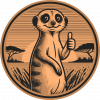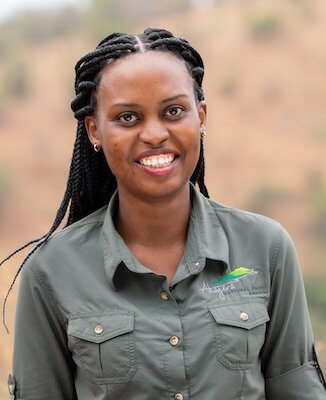Sensors already equip a range of tools to enhance monitoring capacity for conservation. Some of the higher bandwidth technologies, like camera traps and acoustic monitoring systems, have been essential elements of the conservation toolkit for decades, and thus have enough users that we've created dedicated WILDLABS groups to address them. But a whole range of lower bandwidth sensors beyond these core technologies are being increasingly integrated into conservation monitoring systems, and offer rich new insights into the wildlife and ecosystems we're all working to protect. As with many technologies, cost and access have historically been challenges to the adoption of new sensors, but with low-cost and open-source solutions on the rise, we're excited to see what the future of this space holds.
Getting Started with Sensors:
- Watch Shah Selbe's Tech Tutors episode on scaling FieldKit, an open-source conservation sensor toolbox, from a project to a successful conservation tech product.
- Check out our Virtual Meetup about Low-Cost, Open-Source Solutions in conservation tech, including a talk by Alasdair Davies on the Arribada Initiative's work with thermal sensors in early warning systems.
- For a more in-depth introduction, watch the first video in our datalogger mini-series: Freaklabs: How do I get started with Arduino?
In this group, you'll meet others who are using and innovating diverse sensors in their work, discuss ways to make sensors more effective & accessible for conservationists, learn about what sensors are already helping us accomplish in the field, and have the opportunity to ask and answer questions. Join this group to get started!
Header image: Emma Vogel, University of Tromsø
Tech 4 Conservation
President, Tech 4 Conservation
- 0 Resources
- 5 Discussions
- 18 Groups
Botswana Predator Conservation Trust



- 0 Resources
- 72 Discussions
- 10 Groups
A biologist pursuing a Master's in Computer Science and Telecommunications
- 0 Resources
- 1 Discussions
- 2 Groups
- @donovantye
- | He/Him
Savanna Ecologist, Field Station Director and Head of Conservation Tech Projects for Organization for Tropical Studies (OTS).
- 0 Resources
- 0 Discussions
- 14 Groups
- @IsobelAshbey
- | She/her/hers
Running a Tech for Good initiative at Cambridge Consultants, looking for organisations who need help developing new technology for conservation


- 0 Resources
- 7 Discussions
- 5 Groups
Conservation technology enthusiast

- 0 Resources
- 3 Discussions
- 14 Groups
Xerius Tracking
Concerned by wildlife protection and advanced technologies

- 0 Resources
- 3 Discussions
- 7 Groups
Wild Me



- 1 Resources
- 20 Discussions
- 6 Groups
Key Conservation


- 1 Resources
- 19 Discussions
- 6 Groups
Adventure Scientists is a 501(c)3 nonprofit organization based in Bozeman, MT that equips scientists and researchers with high-quality data collected from the outdoors that are crucial to addressing environmental challenges around the world.
- 0 Resources
- 0 Discussions
- 16 Groups
- @DanielHugelmann
- | He / Him
Hi, I'm the co-founder of OceanLabs Seychelles. We design and build environmental and marine remote sensing devices for conservation NGOs. As an engineer and avid diver, with a love for the environment, connecting conservation and technology was the natural thing to do!
- 0 Resources
- 1 Discussions
- 12 Groups
I am both head of the Innovation department and a biodiversity consultant at the Biotope consultancy. Originally a botanist and GIS expert, I specialise in the management of innovation projects, in particular software and technological products dedicated to biodiversity.
- 0 Resources
- 0 Discussions
- 6 Groups
In a recent publication we tested Underwater Passive Acoustic Monitoring (UPAM) as a feasible non-invasive technique to study the calling behavior of therathened aquatic Andean frogs under natural conditions in the...
6 April 2024
Article
You’re invited to the WILDLABS Variety Hour, a monthly event that connects you to conservation tech's most exciting projects, research, and ideas. We can't wait to bring you a whole new season of speakers and...
22 March 2024
This funding opportunity is to support projects to enhance existing, high TRL (7-9) marine biogeochemical sensors and integrate with National Marine Equipment Pool’s autonomous underwater platforms. You must be based...
11 March 2024
The IQOE Task Team on Low-Cost Hydrophones for Research, Education, and Citizen Science is looking for industry partners to develop a low-cost hydrophone.
15 December 2023
Funding
With $60,000, $30,000, and $10,000 grants available for 14 outstanding projects, the support of engineering and technology talent from Arm (the leading semiconductor design company), and access to the world’s biggest...
1 December 2023
Article
Read our interview with Clementine Uwamahoro, African Parks’ Country Manager in Conservation Technology overlooking technology operations for both Akagera National Park and Nyungwe National Park.
29 November 2023
The Department of Applied Ocean Physics and Engineering (AOPE) at the Woods Hole Oceanographic Institution (WHOI) seek to hire 1-2 scientists at any of the Assistant/Associate/Senior Scientist levels to develop research...
27 November 2023
TagRanger® is a state-of-the-art wildlife finding, monitoring and tracking solution for research, conservation and environmental professionals. With superior configurability for logging data, reporting location and...
23 November 2023
Yale University & Map of Life Rapid Assessments - XPRIZE
8 November 2023
Yale University & Map of Life Rapid Assessments - XPRIZE
8 November 2023
Yale University & Map of Life Rapid Assessments - XPRIZE
8 November 2023
The new white paper from Rainforest Connection (RFCx) explores the power of ecoacoustics and AI to monitor biodiversity and track progress towards GBF targets using case studies from around the world.
20 September 2023
April 2024
event
November 2023
event
| Description | Activity | Replies | Groups | Updated |
|---|---|---|---|---|
| Hi everyone, @craig joined last month's Variety Hour to chat about Tagranger, which you can read more about here. A TagRanger®... |
|
Biologging, Connectivity, Sensors | 1 day 8 hours ago | |
| 'Most importantly, we have to make it play a MIDI version of the DoctorWho theme song when you arm the device. That has to be the #1 feature if you ask me!' Seconded! |
+9
|
Acoustics, Biologging, Emerging Tech, Open Source Solutions, Sensors | 2 days 9 hours ago | |
| Sounds good. Just sent you a private message. |
|
Climate Change, Conservation Tech Training and Education, Sensors | 4 days 5 hours ago | |
| This is so cool @Mauricio_Akmentins - congrats and look forward to seeing your project evolve! |
|
Acoustics, Biologging, Climate Change, Conservation Tech Training and Education, Data management and processing tools, Emerging Tech, Open Source Solutions, Protected Area Management Tools, Sensors, Software and Mobile Apps | 1 week 4 days ago | |
| First things first, our team, @jcguerra10, @hefca, and myself, is thrilled to share with immense pride... |
|
Build Your Own Data Logger Community, Data management and processing tools, Sensors | 2 weeks 4 days ago | |
| Hi @Henrikcox I hope you are well. I am not sure if you may remember myself and my colleague from CLS. We had a meeting and met in-person at Earthranger last year. ... |
+15
|
Human-Wildlife Conflict, Sensors | 3 weeks ago | |
| Unless you are planning on making a mesh network between nodes then the total distance spanning the location of all the nodes is important to know, not just the intra node... |
|
Sensors, Protected Area Management Tools | 1 month 2 weeks ago | |
| Hi Danilo. you seem very passionate about this initiative which is a good start.It is an interesting coincidence that I am starting another project for the coral reefs in the... |
|
Acoustics, AI for Conservation, Biologging, Camera Traps, Citizen Science, Climate Change, Community Base, Connectivity, Drones, Emerging Tech, Human-Wildlife Conflict, Open Source Solutions, Sensors, Software and Mobile Apps, Wildlife Crime | 2 months 2 weeks ago | |
| Real nice video. I'll have another look in the weekend in detail. |
+10
|
Acoustics, Community Base, Protected Area Management Tools, Remote Sensing & GIS, Sensors | 2 months 3 weeks ago | |
| Fire detection is a sort of broad idea. Usually people detect the products of fire, and most often this is smoke.Many home fire detectors in the US use a radioactive source... |
|
Community Base, Conservation Tech Training and Education, Data management and processing tools, Ethics of Conservation Tech, Human-Wildlife Conflict, Open Source Solutions, Protected Area Management Tools, Sensors, Wildlife Crime | 2 months 3 weeks ago | |
| Thank you for sharing! Super interesting, as we don't see many underwater stereo cameras! We also use Blue Robotics components in our projects and have found them reliable and... |
|
Sensors, Camera Traps, Marine Conservation | 3 months 2 weeks ago | |
| I am working on a prototype to detect and alert for temic & karbadust. They are used for the poisoning of waterholes in South Africa.... |
|
Sensors | 3 months 3 weeks ago |
How do I choose the right camera trap(s) based on interests, goals, and species?
 Marcella Kelly
Marcella Kelly
6 July 2021 12:00am
GroupGets: μMoth Now Available
 Open Acoustic Devices
Open Acoustic Devices
27 May 2021 12:00am
(Arctic Fox) trap alarm based on LoRa Adafruit
21 April 2021 2:48pm
4 May 2021 9:50am
I realised I actually had a piece of FR-4 fiberglass (perfboard) lying around so I used this as mounting plate. I have also tried fixing the magnet (reed) switch to the plate to hold it in place at the bottom of the box. Will do some neater cable managing as I get the remaining parts. I will try to fit a lipo solar charger next to the radiofeather. I realised that it will be hard to attach USB plugs (for reprogramming or diagnostics) but have ordered some cables with angled plugs hoping they will fit.
I am still considering an additional reed switch as a on-off switch.

20 May 2021 2:41pm
Almost done with the trap alarms.
I added an additional buzzer (with internal circuitry) to get more noise. The added benefit is that the slightly different tunes creates interference that makes the sound much more annoying ;)
I added magnetic on-off switches to all units (under the power managiing unit). The trap release reed switch is located on the other side. I raised the base plates a bit to make room for the lipo batteries underneath them.
Still need to do some more testing on power usage and reliability. I managed a range of 2.5 km, but I believe I could get more when I find a place with better line of sight. I will try to test it over water at a fjiord.

Announcing the Conservation Technology Award
 Conservation Technology Award
Conservation Technology Award
4 May 2021 12:00am
WWF: Carnivore Collaring in Zambia
 World Wildlife Fund
World Wildlife Fund
28 April 2021 12:00am
Webinar: Mission Possible: Deployment
 Wildlife Acoustics
Wildlife Acoustics
21 April 2021 12:00am
Margo Gadfly: A Versatile Wildlife Deterrent
 Margo Supplies
Margo Supplies
31 March 2021 12:00am
The 2021 #Tech4Wildlife Photo Challenge: Community Highlights
25 March 2021 12:00am
Event: 2021 Open Hardware Summit
 Akiba
Akiba
22 March 2021 12:00am
Arm technologies: What do you use?
10 February 2021 9:07pm
11 February 2021 3:45am
Hi Ellie.
This isn't necessarily wildlife but Jacinta and I used the CC1310 wireless chip with the ARM Cortex M3 inside for a project with the International Rice Research Institute. It was to test precision irrigation on rice crops for dry planting and to remove the need for the traditional flood based planting systems. This allows rice to grow in arid regions that traditionally can't support rice as a staple crop. Water scarcity is also a worry for the institute due to global warming, hence focusing on growing rice in low-water environments. There's more information on it here.
For those interested, the CC1310 uses 900 MHz and supports the IEEE 802.15.4 standard. It's one of the standard chips used in the SigFox protocol, although we mainly just used it for communications and not for SigFox implementation. We also implemented a gateway device that collected data from the networked rice paddies and sent water level data to the government server via GSM using SMS. We typically use HTTP but in the Philippines, cellular internet isn't as reliable as SMS, especially in rural areas. Both boards are based on the ARM Cortex M3.
I've attached pics of the wireless sensor boards and gateway we developed for this project as well.
Akiba


1 March 2021 12:33am
I've been tinkering with NVidia Jetson boards for about 2 years now. This is basically a small ARM computer, comes with an Ubuntu image but could run any linux I think. It's basically a mini computer with an Nvidia GPU, so you can do all sorts of things at 'the edge'.
I have been (on and off) building a bird feeder camera that would id birds and send just the text not images. Ultimately I would like to build a smart camera trap that would id animals and conserve bandwith by just uploading the data.
I started with the Jetson Nano, about 100 USD but when I started it was difficult to do things due to ARM.
Now I am working with a Jetson NX, about 500 USD and things are way easier. Visual Studio Code runs there natively, as do many python libraries and there are even a lot of containers ready made now.
Also, AWS has Graviton instances now - an EC2 ARM computer. One of my plans is to use AWS for building, testing, etc. and now ARM is an option there too.
12 March 2021 7:08pm
Hi Barry,
I am tinkering with similar edge devices and aspirations! I recently acquired the Jetson Nano to start testing some aspects of the BearID Project software pipeline. What were the main issues with the Nano? Is it mainly the build process (speed and memory)? The NX uses very similar CPU cores (but 6 instead of 4), bigger/faster DRAM (8GB vs 4GB) and much faster GPU (especially if you are using INT8 instead of FLOAT32). I'm also playing around with Raspberry Pi and a hardware accelerator.
The Arm-based EC2 instances on AWS should be a great help in compilation!
Full disclosure: I work for Arm, but developing on these platforms is not part of my role there. This is purely a passion project!
Ed
Funding Opportunity: COVID-19 Science Fund
 National Geographic
National Geographic
10 March 2021 12:00am
Method for mapping & finding nest boxes
29 September 2020 12:03pm
1 March 2021 11:10am
I don't know much about them either. I do not think they need to face a certain way.
I am pretty sure they can be bougt in bulk. That is what the outdoor clothes companies do.
Try contacting Dale Atkins from RECCO.
2 March 2021 2:52am
Hi Lars, Nida,
Riffing on the Recco idea, if you have access to the detector, it's possible to make a Recco-compatible reflector for very cheap, since for this purpose it won't need to be sewn into clothing or put through a washing machine. There is no magic behind the reflector technology, I think it can be made in small quantities for USD1-2/each. It is basically RFID technology, and you know how cheap they're trying to be. Here is a paper talking about just that. Especially take a look at their reference [4], which details an attempt at making Recco-compatible reflectors, but using older components (the paper was published in 1997). There are much better components now.
I bet Recco detectors are expensive. But there's a way around that! 434MHz transmitters and 868MHz receivers are easy to get; together, these constitute the detector. Another possibility is 13.56MHz/27.2MHz. Not sure about the detection range though.
Thanks,
-harold
9 March 2021 9:26am
Thanks for the paper Harold, this looks like a possibility. Especially if there's a way to make bespoke detectors
Virtual Event: FieldKit Open House
 FieldKit
FieldKit
9 March 2021 12:00am
Virtual Event: Carnivores and Camera Traps
4 March 2021 12:00am
Looking for old/dummy Vectronics collars
3 March 2021 8:07am
Collaboration Spotlight: BoomBox
 Ellie Warren
Ellie Warren
26 February 2021 12:00am
WWF: Protecting Ferrets with Drones and Vaccines
 Kristy Bly
Kristy Bly
17 February 2021 12:00am
News: FieldKit Presales and WSJ Feature
 FieldKit
FieldKit
11 February 2021 12:00am
How do I get started with LoRa? Connectivity in conservation
1 February 2021 12:00am
Protecting Wildlife with Machine Learning
 Hack the Poacher
Hack the Poacher
29 January 2021 12:00am
New Paper: Empowering Rangers Through Technology and Innovation
 Drew Cronin
Drew Cronin
27 January 2021 12:00am
WWF: Using Technology to Detect and Protect the Endangered Black-Footed Ferret
 Kristy Bly
Kristy Bly
19 January 2021 12:00am
Sustainable Fishing Challenges: Fish Catch Monitoring
 Daniel Steadman
Daniel Steadman
4 December 2020 12:00am
Making the Most of Tech Tutors Season 2!
30 November 2020 12:00am
Kaggle Competition: Species Audio Detection
 Rainforest Connection
Rainforest Connection
24 November 2020 12:00am
WILDLABS Tech Tutors: Season Two
24 November 2020 12:00am
Conservation Technology User Guidelines Issue 5: Drones
 World Wildlife Fund
World Wildlife Fund
18 November 2020 12:00am
WILDLABS: Building a Better World with ‘Bad’ Data
17 November 2020 12:00am
Water intermittency data logger
10 December 2018 4:23pm
18 January 2019 7:21pm
Hello Erick
A few comments that you may find useful.
Before I start, I am not a complete Arduino beginner but I am certainly no expert either.
I quote British suppliers' websites below but you should find some local to you that offer the same components. If in doubt you can always try Mouser or Digikey (though mind the delivery charges for low value orders).
ARDUINO
1. SIZE - If you want to keep things small and do without a lot of the connectors etc. that come with the "standard" Arduino UNO then have a look at the ARDUINO PRO MINI. A postage stamp size unit with plenty of digital and analogue input/output as well as onboard voltage regulator to give you some flexibility on power supply.
Having said that, you already found out that by default Arduinos are not that energy efficient. But there is help at hand if you don' t mind getting a little more immersed in the electronics. See here for a very useful and detailed tutorial that worked a treat for one of my projects:
http://www.home-automation-community.com/arduino-low-power-how-to-run-atmega328p-for-a-year-on-coin-cell-battery/
2. OPERATING VOLTAGE AND CPU SPEED - There are Arduino Pro Mini versions operating at 3.3 or 5V, 8 or 16 MHz. Unless you need lots of processing power (unlikely from your description), then the 8 MHz version will do perfectly well. Pick the voltage version depending on the peripherals you are going to use. There are usually, but not always, 3.3 and 5V versions. SD card readers, for example, operate at 3.3V and those suited for a 5V Arduino have onboard level shifters to convert voltage levels.
http://www.hobbytronics.co.uk/index.php?route=product/search&keyword=arduino%20pro%20mini
3. SAVING ENERGY - I guess you don't need continuous measurements but just, say, once an hour. In so far, you could use slightly more energy-intensive measurement devices as they (and the Arduino) will only ever run for a few seconds at a time. On that note, you should be able to power all or at least some of the peripherals off output pins of the Arduino. They only supply a few 10mA but this is enough in most cases. Use two outpins per device, one set to LOW (for 0V) and one set to HIGH (for 3.3 or 5 V). Larger devices would have to be switched on and off through a transistor or even relay that is controlled by the Arduino.
REAL TIME CLOCK
Beware of some of the cheaper RTCs. I found to my detriment that, e.g. DS1302, does not keep time well at all to the point of being entirely useless. Better spend a few bob more and get something like the DS3234, which worked fine for me.
http://www.hobbytronics.co.uk/rtc-ds3234?keyword=rtc
MEASURING WATER FLOWS
If at all possible, measure contactless. As soon as you get your sensor anywhere near the actual stream, you are exposing it to all manner of potential trouble including debris getting washed onto it, clogging any mechanical sensor and possible upsetting most other "direct contact" sensors. Having said that, there don't seem to be all that many off-the-shelf options so here are some ideas off the top of my head.
Digikey sells the same sensors previously suggested from Adafruit but they also have a range of other "immersible" sensors that are lot cheaper:
https://www.digikey.com/products/en/sensors-transducers/optical-sensors-photointerrupters-slot-type-transistor-output/548?k=optical%20liquid%20sensor
A waterproof capacitive sensors may be an option but this would have to be helddown or burried on the stream bed:
https://www.ebay.com/itm/DC-5-24V-Contactless-Liquid-Level-Sensor-Switch-Non-Contact-Waterproof-Detector-/122834485435
An entirely different approach but definitely non-contact: use a small camera module and machine vision to detect the change of state between dry and wet. To do the processing of this on an Arduino would likely be a challenge, then again, what you are looking for is quite a simple change in visual appearance that may be possible to detect without too much processing.
POWER SUPPLY
If you are operating in the desert then I expect a small solar panel with battery should provide you all the power you need for such a small unit. I can't give you much more details on something custom-made but if you want to keep things simple then use an off-the-shelf device with a USB-style connector (get the 5V Arduino in this case). Better yet, use something that has something more robust than a USB port. If all else fails, use something like Sugru to beef-up the USB socket and plug against accidental damage and disconnection.
https://sugru.com/
Good luck and do have fun !!
J
21 January 2019 3:21pm
Hi @j.neff! These are great tips. I am floored by the generosity of this community, thank you! My progress on this project has been slightly stalled - but I just received the components to solder together the RTC that @Alasdair recommended. Hopefully I can get back onto that train soon, as summer is rapidly approaching!
Thanks for sending these other components and ideas, I will update this thread as soon as a beta version of this device is complete!
All the best,
Erick
13 November 2020 7:18am
Really interesting chat.
I was looking at this "eTape" to measure inundation on marine turtle nests.
https://www.adafruit.com/product/463
Will give you water presence and level if you are interested in more than just presence-absence.
The water level reading seems to be continue, but I guess it can be logged or powered only at requested intervals.
Good luck
Hackathon Opportunity: Vaquita Hacks
 The Conservation Project International
The Conservation Project International
10 November 2020 12:00am
















































26 April 2021 7:03pm
Hi and thanks for your tips, Akiba!
I was actually thinking about the little greenhouse effect today when leaving the box in the afternoon sun. It is a rather cold environment in Greenland were I will deploy these though, so I may be OK. I can always give the tops a bit of white or silver paint. For the base station, I like to be able to see the LEDs directly on the board. This will also not be left out in the sun.
I will try to get some 2mm acrylic sheet for the mounting plate, thanks!
Cheers,
Lars